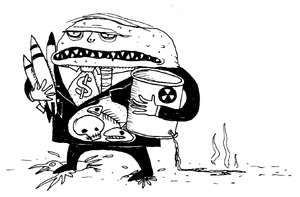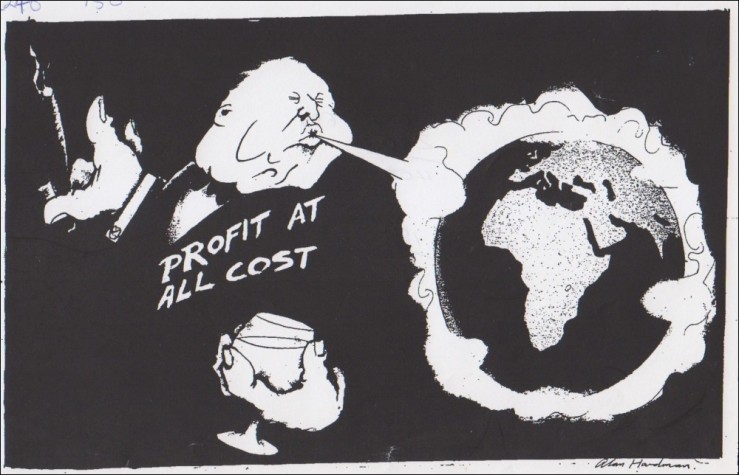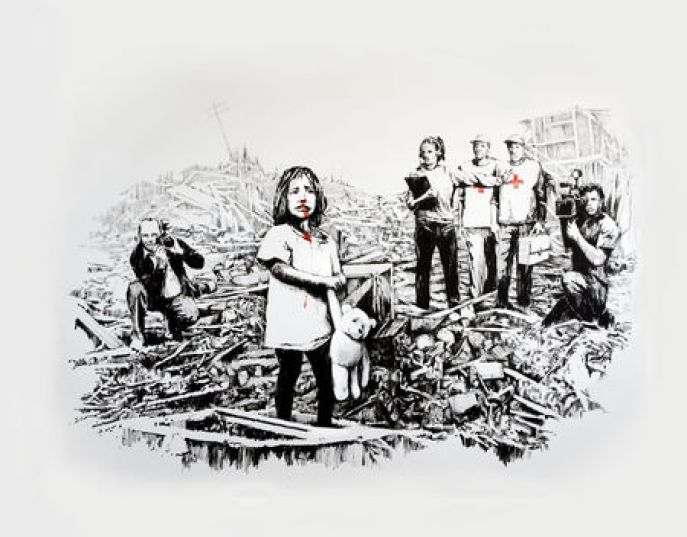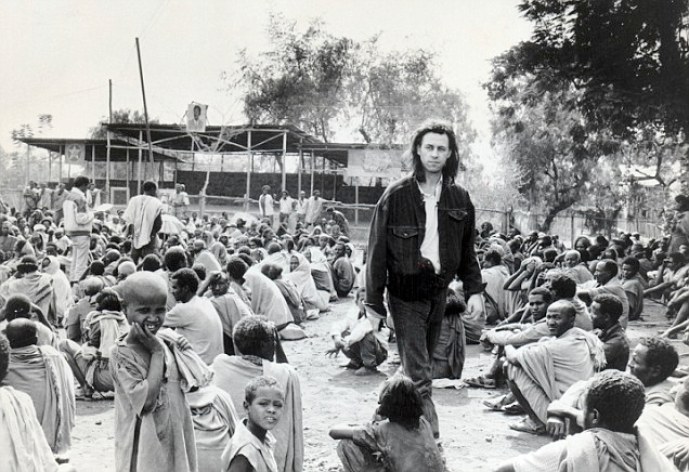May 05
20170
Social Engineering, Whiteness & Aversive Racism
Capitalism Green Economy Imperialism Militarism New Economy Payment for Ecosystem Services (PES) Renewable Energy UNFCCC
The Green Economy as a Continuation of War by Other Means
February 2, 2016
by Alexander Dunlap
The following essay has been modified from a speech given at the 10th Conference of Critical Justice in Latin America (X Conferencia Latinoamericana de Crítica Jurídica) on April 23, 2015 on a panel titled: “Rights, Dependency and Capitalist Accumulation in Latin America” (Mesa Derecho, dependencia y acumulación capitalista en América Latina). This speech was based on the paper, “The Militarisation and Marketisation of Nature: An Alternative Lens to ‘Climate-Conflict,’” (Geopolitics, 2014) while also building from it, discussing some examples from wind turbine development in the coastal area of the Isthmus of Tehuantepec region in Oaxaca Mexico, known as the Istmo.
What these lifestyles are dependent on are a series of systemic processes: those of industrial waste that result from mining, oil extraction, electricity generation, cars, concrete, asphalt, electronics, and the list goes on. And climate change is really just the result of needing to make this list of resource extraction and technologies grow for the last two hundred years, while intertwining this need with our daily lives.
So when we understand climate change as an issue that is bigger than us, it prevents reflection, inhibits agency, and sends the message that only governments, corporations and NGOs can stop this phenomenon. Yet these institutions’ mitigation and security practices only serve to reinforce global environmental degradation, for the mainstream framework of climate change, while acknowledging a cumulative problem, also projects submission to authority and governing structures that have created new “dystopian markets” with ideas of geo-engineering (see Simon Dalby’s “Geoengineering: The Next Era of Geopolitics?” Geography Compass, 2015).
As I hope to show in the lines that follow, we must acknowledge that climate change has been wielded as a neoliberal weapon to create the idea of the “green economy” in the hopes of maintaining the state and growing economies. These are processes that continue land conflict and pacification through climate change mitigation initiatives and an environmental ethic with various notions of sustainability.
“Green grabbing”
Mainstream notions that seek to address climate change are deeply intertwined with ideas of sustainable development that emerged in the 1970s with the Club of Rome and the 1987 United Nations’ (UN) report Our Common Future, where it was recognized that industrial development had to soften and change its course otherwise it would destroy itself and many of the people dependent on it.
The 1992 Rio+20 Earth Summit recognized climate change and biodiversity loss as critical issues, which would lead to the creation of the UN Framework Convention on Climate Change (UNFCCC). It would then give way to the 1997 Kyoto protocol that decided market mechanisms would be the principle way forward to mitigate the problem of climate change and biodiversity loss.
Now enters the notion of Payment for Ecosystem Services (PES) that has sought to integrate market processes into the natural environment to dissect and quantify it, so that corporations and philanthropists can pay to keep forests standing and “natural resources” intact.
For businessmen and stupid environmentalists alike, these proposals have been called a “win-win” solution. These areas have been cordoned off on the false and historically genocidal premise of “pristine” or “wild nature,” which claims that humans but specifically indigenous peoples cannot live in forests if they are to be “saved”, conserved, and maintained as “pristine.” As I hope many know, this is contrary to the historical record as many indigenous people made the pristine forests of the Amazon and the world (see my previous work with James Fairhead: “The Militarisation and Marketisation of Nature,” Geopolitics, 2014.)
These are the same areas that are now the new frontiers of capital investment; these new measures and market mechanisms have now made new markets out of trees, plants, and animal life with notions of “carbon sequestration” and “biodiversity.” These novel and strange terms are used to measure and quantify the natural environment and support the commodification and transformation of larger and “exotic” wildlife into a spectacle for office workers and the wealthy with the rise of ecotourism.
Most recently we have the “green market” as the latest pretext to take over land, displace native groups, and create new sustainable development initiatives while powering the cities and factories with renewable energy, often in the name of slowing anthropogenic climate change. Journalist John Vidal has dubbed this capture of land through sustainable development using an environmental rational as “green grabbing,” gesturing to a shared logic of “land grabbing” Marx once termed to describe the systematic theft of communal property from the 15th to 19th centuries.
It is no surprise that these friendly and environmentally conscious ideas have continued the trajectory of the industrial economy, for there was never once a reflection about slowing this industrial cancer that has become so common.
The green economy as counterinsurgency
We should also remember that the history of state craft, development, and the market has been firmly rooted in waging a war for the submission and acquiescence of people and the natural environment into its organizational structure and growth. Nancy Peluso and Peter Vandergeest have shown how geographical landscapes and towns are built on campaigns of widespread terror against both people and the natural environment, whether in colonial, post-colonial or democratic countries (“Political Ecologies of War and Forests: Counterinsurgencies and the Making of National Natures,” Annals of the Association of American Geographers, 2011).
Terrorizing unruly people into submission has always been a perquisite for all states to establish a territory and gain a grasp on, and make legible the people, forest, minerals and animals of “the nation”—after all, the kings, empires and states claimed it as their own and because we were their “subjects” this was never a problem, right? This means that if people are not revolting, they are submitting to a claim brought upon them, and this claim was always met with resistance.
The people and the forest worked together to wage every type of insurgency against the colonial, post-colonial and democratic regimes in different times and places in Asia, Africa, and the Americas. In general, one can see a pattern that required all states to terrorize and traumatize people through campaigns of counterinsurgency warfare, resettlement campaigns into suburban style villages, cities, and factories with an overall goal to corral and integrate people into “modern” work, national culture and the demands of the economy. Indeed, all states have been at war to subjugate and colonize the people of their “territory” to the imperatives of its organization, which demarcated “Jungles” wild, from “forests” controlled, and forests from agriculture, regimenting every aspect of life and environment to the principle of separations inherent in scientific method. It is under this history of war that the economy and now the green economy stands.
Placing the green economy within the framework of counterinsurgency, the leading theory of state sanctioned pacification, is insightful in this regard. For example, David Kilcullen, Lieutenant Colonel in the Australian Army and a leading counterinsurgency strategist, defines counterinsurgency as “a competition with the insurgent for the right and ability to win the hearts, minds and acquiescence of the population” (“Twenty-Eight Articles: Fundamentals of Company-Level Counterinsurgency,” 2006 [PDF]). Here, the term “hearts” is described as “persuading people their best interests are served by your success,” and the term “minds,” as “convincing them that you can protect them, and that resisting you is pointless.” The green economy is thus an advancement in capturing people to rally for the survival of the economy and business imperatives of the state and its corporate partners—and this in both the city and countryside.
Inclusionary control as pre-emptive pacification
By now, most people have formed their identities and habits around this industrial system, and are attracted to ideas about carbon and biodiversity offsetting, participatory conservation, and renewable energy that provide us with illusions that life and the economy can co-exist. But in many ways this is not true.
Taking the Barra de Santa Teresa near where I live as an example, Mareña Renovables/Eólica del Sur wants to build upwards of hundred industrial wind turbines (aerogeneradore), on a scared and rare ecological zone that took 10,000 years to form, but guess what? The Barra is made of sand and vegetation, which means they will have to pour around a kilometer or possibly more of concrete for their foundations—individually for around one-hundred industrial wind turbines. This is an insane amount of concrete that will no doubt destroy the water table, and create an excess of sand, which as I was told by coastal ecologist, Patricia Mora, “will be total ecological devastation.”
The green economy is advancing techniques of “inclusionary control,” which is a way to include more humans and non-human lives into state and market structures. However, the mid-to-long-term interest of people is to not take the money or questionable promises of jobs, but to get rid of these structures and rehabilitate the land with healthy soil, fruit trees, and animals so they can secure food, shelter, and work to build healthy environments.
Inclusionary control is counterinsurgency and the art of preemptive pacification, which is the art of including people to exclude and neglect their structural grievances—no/crap jobs, no/crap education, drinking toxic waste, police violence, and the standardization of life (the box system) and so on— that is inherent in states, economies and capitalism of every brand. It is why the importance of transforming one’s task into improving the environment is multiplied tenfold if people also value their cultures, land, and lifestyles not being entirely dependent on the economy.
Free, Prior and Informed Consent as Inclusionary Control
An interesting mechanism that is being deployed in the Istmo right now, in the struggle over the invasion of thousands of wind turbines, is the UN’s Free, Prior and Informed Consent (FPIC) procedure, which is mandatory for signatory nations to conduct when constructing development projects on indigenous lands and communities. This mechanism, a success after years of struggle for indigenous recognition, could be important for stalling and fighting megaprojects.
Nevertheless, if people are not conscious, if they are divided and fighting each other—the goal of all governments, corporations and drug dealers alike—then this mechanism can be used by corporate-state alliances to pacify people with the feeling that they are being heard, included, and consulted. It will then reaffirm the strong mythology of democracy that everyone wants to desperately believe in.
But for some reason, whether democracy or dictatorship, people are never really permitted the simple answer: No, we do not want these projects here. No we do not want a form of development that is our submission to factories, migration, and mechanized labor. Rights create constructs of illusion that will always mediate the power of people through states and as I am watching now, FPIC is in a way similar to a ceasefire that allows the deception and fragmentation of people in resistance, while the state, companies and unions can re-strategize and regroup their forces.
Likewise, as I have argued in another paper about UN-REDD+, FPIC is equivalent to an indigenous Miranda Rights (“The Expanding Techniques of Progress: Agricultural Biotechnology and UN-REDD+,”Crossmark, 2014). Miranda rights in the United States are your rights once you have been arrested—“you have the right to remain silent, seek legal counsel,” and so on. In the case with the FPIC in the Istmo, it tells people that you have the right to be consulted by experts, to voice your grievances, and fight for jobs, but while we talk 18 parks are being constructed, with more planned on top of Ejidos and communal land [Silvia Chavela Rivas, “Eólicas: ocaso o resplandor?” 2015 [PDF, Spanish]).
In short, people are being arrested to the imperatives of economic growth and industrial expansion that will destroy life, make alternatives more difficult and create the collective fate of shuffling papers, pimping plastic and flipping burgers—a fate that is already a reality for many, many who often do not care about wind turbines and whose desires and projectuality tend to mimic what is televised in soap operas and music videos.
FPIC is a way to implicate people and hang them with their own participation and rights, when really people have their best interest in rejecting all mediation by state and corporate structures and coming together to create alternative projects, perspectives and even ‘jobs’—since this is a selling point for wind turbines in the region—to improve their lives, but in the end, the hierarches supported by the state and the powers that they bear will not let them without a brutal fight.
War is complex and the green economy is advancing land acquisition and displacement, claiming to fight environmental degradation, while simultaneously advancing it. It is nothing short than crazy, and it is a type of psychosis built in the fantasies of the American or development dream that either are not true for many, hollow for those who achieve it, or maybe it is the answer to everything. Either way, regardless of the different trajectories everyone will still be working to propel the modern industrial system. Probably in an office or some type of building, losing your vision and breath to a computer, trapped in a toxic environments, when really humans should probably be working for healthy, happier and freer lives and we must acknowledge that freedom is disingenuous when it is capturing and killing the people around you, both human and non-human alike.
[Alexander Dunlap is a doctoral candidate in the Department of Social and Cultural Anthropology at Vrije Universiteit Amsterdam. His current research focuses on the social impact of wind energy projects in the Isthmus of Tehuantepec, Mexico. He can be contacted at a.d.dunlap@vu.nl]
































